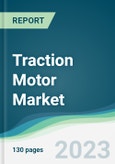The traction motor market was valued at US$13.833 billion in 2021.
Electric motors are called traction motors which are used to move several types of vehicles, including locomotives, electric or hydrogen cars, and electric multiple units such as trains, electric milk floats, trolleybuses, elevators, and roller coasters. The traction motor market is expected to rise as a result of rising demand for high-performance electric traction motors, supportive government regulations and subsidies for electric vehicles, and an increase in railway electrification projects. The growing demand for electric vehicles and rising construction investments are expected to have a large demand for traction motors which will boost the overall market growth during the forecasted period.
The growing infrastructure and construction investments is augmenting the traction motor demand.
The DC series motors, a type of traction motor, are useful in the construction sector since they are used in heavy-duty applications, including electric locomotives, steel rolling mills, hoists, lifts, and cranes due to their powerful starting torque and variable speed. The increasing government investment in construction projects is expected to boost the demand for traction motors. In 2019 the National Development and Reform Commission of China authorized 26 infrastructure projects with completion dates projected for 2023. In October 2021, according to Infrastructure Australia, there will be a two-fold increase in significant infrastructure projects involving residential, civil, and commercial construction during the following three years. During the next ten years, an estimated $290 billion will be invested, almost tripling in the following three years. According to the US census bureau, total construction spending has increased from 1,501,841 million dollars in February 2020 to 1,844,105 million dollars in February 2023. These rising construction projects and investments by the government will drive the traction motor market growth.
The growing application in the transportation sector is accelerating the adoption of traction motors.
The need for transportation is expanding quickly, which is increasing the usage of traction motors used in electric trolley buses and railways networks. These traction motors are powered by electricity, which is used to produce the force needed to move the train's wheels. The railway’s transportation uses traction motors due to their strong torque and accurate speed control. The increasing electrification and government investment in the railways will boost the traction motor market growth. In March 2023, the Indian Ministry of Railways launched trains called the Bharat Gaurav, which are being run to highlight India's magnificent historical sites and rich cultural legacy. According to the U.S. Energy Information Administration (IEA) statement in January 2019, the rail industry is the only method of transportation that has been extensively electrified today, with electric trains now accounting for 75% up from 60% 2000 of all passenger rail transport activity. This growing railway transportation investment by the government in the sector will boost the traction motor market growth.
The Asia Pacific will account for a major market share in 2021.
The Asia Pacific region will dominate the market as a result of increased construction investments and production of electric vehicles for transportation, which has fuelled demand for traction motors in the Asia Pacific region, thereby boosting regional market growth. According to data from the International Organization of Motor Vehicle Manufacturers (OICA), the Asia Pacific region saw a 27% increase in its bus & coaches production from 140,234 units in 2021 to 177, 657 in 2022, while India saw a 111% increase in the production of coaches used in railways from 2021 to 2022. In November 2021, Indian railways announced that 102 semi-high-speed vande bharat express trains are expected to start running by 2024, with at least 10 new trains that will connect 40 cities set to debut by August 2022 and Indian railways hopes to electrify all broad-gauge railways by 2023. In April 2023, according to the International Trade Administration, over the course of China’s 14th Five-Year Plan (2021-2025), over 27 trillion yuan ($ 4.2 trillion) will be invested in new infrastructure construction. This increasing development in the railway sector coupled with favorable investments in the construction sector, is expected to accelerate the traction motor market growth in the Asia Pacific region.
Market Developments:
- In November 2022, the Polish-based Elimen Group and electronic component manufacturer Flash announced their collaboration to produce traction motors and controllers for electric vehicles in India.
- In September 2022, Sona Comstar announced that it had reached a production milestone of 100,000 ev traction motors with doubled in just four months at its Chennai plant.
Market Segmentation:
By Type
- Three-Phase Induction Motor
- Linear Induction Motor
- AC Series Motor
- DC Series Motor
By End-User
- Transportation
- Industrial
- Construction
- Others
By Geography
- North America
- USA
- Canada
- Mexico
- South America
- Brazil
- Argentina
- Others
- Europe
- Germany
- UK
- France
- Spain
- Others
- Middle East and Africa
- Saudi Arabia
- UAE
- Others
- Asia Pacific
- China
- Japan
- South Korea
- India
- Australia
- Others
Table of Contents
Companies Mentioned
- ABB Ltd.
- Toyo Denki Seizo K.K
- Siemens
- Toshiba International Corporation
- Nidec Motor Corporation (Nidec Group)
- CG Power & Industrial Solution Ltd.
- TITAGARH Wagon Limited
- Kirloskar Electric Company
Methodology

LOADING...








